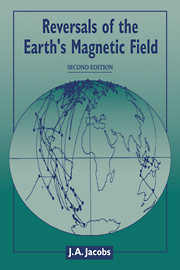Book contents
8 - The Earth's magnetic field and other geophysical phenomena
Published online by Cambridge University Press: 23 September 2009
Summary
Introduction
In this chapter possible relationships between the Earth's magnetic field and other geophysical phenomena will be discussed. This will include climate, which is a rather grey area, and, in spite of the increasing interest and vast literature on the subject, little convincing evidence for correlations has been obtained. Another grey area is possible relationships between magnetic reversals, impacts and faunal extinctions, which will be discussed in Section 8.4. Finally, the possibility of a connection between events at the Earth's surface and those in the core, where the Earth's magnetic field is generated, will be reviewed. In the past it has always been considered unlikely that the solid, rocky, mantle and the fluid, mainly iron, outer core could influence one another.
The orbital climatic theory of Milankovitch
The first suggestion that orbital variations might affect climate was made in 1830 by John Herschel. The idea was revived many times, more recently by Milankovitch in 1941, with whose name it is now associated. The theory holds that regular, predictable changes in the orientation of the Earth's axis of rotation and the shape of its orbit affect the distribution of sunlight over the Earth's surface. The tilt of the Earth's axis away from the plane of its orbit (its obliquity ε) varies between 22.1° and 24.5° (it is now 23.5°). Since it is the obliquity which causes seasons, a cyclic variation in the obliquity will in turn produce a cycle in the strength of the contrast between seasons. The Earth's axis of rotation also precesses, describing a small circle among the stars. This is measured as the angular distance ω of perihelion from the autumnal equinox.
- Type
- Chapter
- Information
- Reversals of the Earth's Magnetic Field , pp. 258 - 293Publisher: Cambridge University PressPrint publication year: 1994



